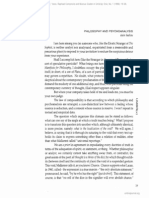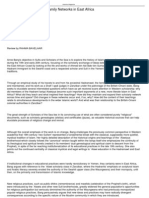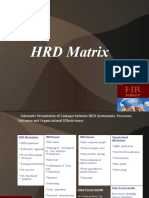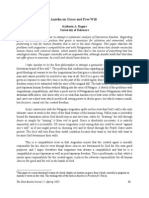From Alid Treatise To Anti Shii Text T
From Alid Treatise To Anti Shii Text T
Uploaded by
andini14damasariCopyright:
Available Formats
From Alid Treatise To Anti Shii Text T
From Alid Treatise To Anti Shii Text T
Uploaded by
andini14damasariOriginal Title
Copyright
Available Formats
Share this document
Did you find this document useful?
Is this content inappropriate?
Copyright:
Available Formats
From Alid Treatise To Anti Shii Text T
From Alid Treatise To Anti Shii Text T
Uploaded by
andini14damasariCopyright:
Available Formats
Islamic Law and Society 27 (2020) 411-438
From ʿAlid Treatise to anti-Shiʿi Text: the Riṣāla fī
ibṭāl bidaʿ munkarāt of ʿAbdallāh b. ʿUmar Bin Yaḥyā
(d. 1265/1849) and its Afterlife in Indonesia
Ismail Fajrie Alatas
Department of Middle Eastern and Islamic Studies, New York University,
New York, NY, USA
ifalatas@nyu.edu
Abstract
This article examines a little-known treatise on the commemoration of ʿĀshūrāʾ (the
martyrdom of al-Ḥusayn, the grandson of the Prophet Muḥammad) written by a scholar
from the Ḥaḍramawt, ʿAbdallāh b. ʿUmar Bin Yaḥyā (d. 1265/1849). Entitled Risāla fī ibṭāl
bidaʿ munkarāt (Treatise on Nullifying Reprehensible Innovations), the text was composed
in response to the ʿĀshūrāʾ commemorative processions introduced by South Asian
Muslims in early nineteenth century Malay-Indonesian Archipelago and witnessed by
the author during his travel there (1832-1835). In this treatise, Ibn Yaḥyā defines a lawful,
regulated, and emotionally restrained way of commemorating al-Ḥusayn’s martyrdom
while stressing the imperative of ʿAlid leadership of the umma. I then discuss the recent
resurfacing of a redacted summary of the Risāla in Indonesia. I show that in the context of
an increasingly intense Sunni-Shiʿi sectarian contestation that characterized contemporary
Indonesia, the redacted version of this ʿAlid treatise circulates as an anti-Shiʿi text.
Keywords
Shiʿism – ʿĀshūrāʾ – Southeast Asia – Alid Piety – bidʿa – Ḥaḍramawt – kutub al-bidaʿ –
Rāfiḍa
In his monumental History of Sumatra – first published in 1783 and expanded
in 1811 – the English orientalist and pioneer in the modern scientific study of
Indonesia, William Marsden (d. 1836), made the following comments regard-
ing the religion of the Malays:
© koninklijke brill nv, leiden, 2020 | doi:10.1163/15685195-00260A16
412 alatas
The Malays, as far as my observation went, did not appear to possess much
of the bigotry so commonly found amongst the western Mahometans, or
to show antipathy to or contempt for unbelievers. To this indifference is
to be attributed my not having positively ascertained whether they are
followers of the sunni or the shiah sect, although from their tolerant prin-
ciples and [from] frequent passages in their writings in praise of Ali, I
conclude them to be the latter.1
While this passage can be read as Marsden’s misapprehension of the religion
of the Malays, it also points to the absence of sharply defined sectarian iden-
tity among Malay Muslims in the late eighteenth century.2 Scholars have high-
lighted the widespread veneration of the family of the Prophet Muḥammad,
the ahl al-bayt, in local literary tradition and ritual practice – including the
commemoration of ʿĀshūrāʾ, that is, the martyrdom of the Prophet’s grandson
al-Ḥusayn at the battle of Karbala (61/680) – across Southeast Asia.3 Such lit-
erary and ritual practice does not necessarily point towards the dissemination
of Shiʿism – let alone Shiʿi political, theological, and legal ideas – in the region.
1 William Marsden, The History of Sumatra, containing an account of the government, laws,
customs, and manners of the native inhabitants, with a description of the natural productions,
and a relation of the ancient political state of that island (3rd ed. London: Longman, Hurst, Rees,
Orme, and Brown, 1811), 346.
2 R. Michael Feener and Chiara Formichi, “Debating ‘Shiʿism’ in the History of Muslim Southeast
Asia,” in Shiʿism in Southeast Asia: ʿAlid Piety and Sectarian Constructions, ed. Chiara Formichi
and R. Michael Feener (London: Hurst & Company: 2015), 4-5.
3 S.Q. Fatimi, Islam Comes to Malaysia (Singapore: Malaysian Sociological Research Institute,
1963); L.F. Brakel, The Hikayat Muhammad Hanafiyyah: A Medieval Muslim Malay Romance
(Den Haag: Nijhoff, 1975); Baroroh Baried, “Shi‘a Elements in Malay Literature,” in Profiles of
Malay Culture: Historiography, Religion and Politics, ed. Sartono Kartodirdjo (Jakarta: Ministry
of Education and Culture, Directorate General of Culture, 1976), 59-65; Vladimir Braginsky,
“Jalinan dan Khazanah Kutipan: Terjemahan dari Bahasa Parsi dalam kesusastraan Melayu,
khususnya yang berkaitan dengan ‘Cerita-Cerita Parsi’,” in Sadur: Sejarah Terjemahan di
Indonesia dan Malaysia, ed. Henri Chamber-Loir (Jakarta: Gramedia, 2009), 59-118; Edwin
Wieringa, “Does Traditional Islamic Malay Literature Contain Shiitic Elements? Ali and
Fatimah in Malay Hikayat Literature,” Studia Islamika: Indonesian Journal for Islamic Studies, 3:
4 (1996), 93-111; Christoph Marcinkowski, “Shiʿism in Thailand: From the Autthaya Period to the
Present,” in Shiʿism in Southeast Asia, 31-49; Ronit Ricci, “Soldier and Son-in-law, Spreader of
the Faith and Scribe: Representation of ʿAlī in Javanese Literature,” in Shiʿism in Southeast Asia,
51-62; Wendy Mukherjee, “Fāṭima in Nusantara,” in Shiʿism in Southeast Asia, 63-78; Faried F.
Saenong, “ʿAlid Piety in Bugis Texts on Proper Sexual Arts,” in Shiʿism in Southeast Asia, 99-114.
For a bibliographical survey of literature on Shiʿism from the late nineteenth century to the
present, see Majid Daneshgar, “The Study of Persian Shiʿism in the Malay-Indonesian World: A
review of literature from the nineteenth century onwards,” Journal of Shiʿa Islamic Studies, 7: 2
(2014), 191-229.
Islamic Law and Society 27 (2020) 411-438
from ʿalid treatise to anti-shiʿi text 413
Nevertheless, it does allude to the presence of what has been described as
“ʿAlid loyalism” or “ʿAlid piety” that centered on forms of reverence towards the
ahl al-bayt among Southeast Asian Muslims.4
In the course of the nineteenth century, however, certain forms of ʿAlid piety
came under censure. L.F. Brakel, followed by Edwin Wieringa, describe this
process as the de-shiʿitization of Islam in Southeast Asia, which left Shiʿi traces
in local Islamic literature and practices “generally not recognized as such by
the common (Sunni) believer.”5 Brakel suggests that Shiʿism “must have played
a definite (and most likely quite considerable) part in the moulding of early
Indonesian Islam” before becoming more Sunnified.6 Building on Brakel’s
argument, Wieringa attributes the de-shiʿitization process to the intensifica-
tion of contact between Southeast Asia and Arabia brought about by (1) the
rising number of Southeast Asian pilgrims and students in the Hejaz, and (2)
the increasing prominence of Ḥaḍramī sāda (sg. sayyid, i.e. a descendant of the
Prophet Muḥammad) in Southeast Asia. In Wieringa’s view, both phenomena
resulted in the purging of “elements of Perso-Indian origin” from the articula-
tions of Islam in Southeast Asia.7
Responding to Brakel and Wieringa, Michael Feener and Chiara Formichi
have recently suggested that if indeed there was a de-shiʿitization, such a pro-
cess “was not pursued in a comprehensive or totalizing manner” and that “ele-
ments of ahl al-bayt devotion were incorporated in a doctrinally Sunni body of
literature.”8 This intervention by Feener and Formichi opens up new ways for
thinking about the nineteenth-century reconfiguration of Islam in Southeast
Asia, in two ways. First, rather than positing the existence of hard sectarian
boundaries that hinged on stable Sunni and Shiʿi identities, we should instead
recognize the centrality of ʿAlid piety, together with the absence of clearly
4 On the term “Alid loyalism,” see Marshall Hodgson, “How did the Early Shiʿa become Sec-
tarian?,” Journal of the American Oriental Society, 75 (1955), 1-13. On the term “ʿAlid piety,” see
Feener and Formichi, “Debating ‘Shiʿism,” 4-5. ʿAlid piety is not unique to Southeast Asia.
Scholars have documented forms of ʿAlid piety among Sunni Muslims of Morocco, Egypt, and
South Asia. See Vincent J. Cornell, Realm of the Saint: Power and Authority in Moroccan Sufism
(Austin: University of Texas Press, 1998); Valerie J. Hoffman-Ladd, “Devotion to the Prophet
and His Family in Egyptian Sufism,” International Journal of Middle East Studies, 24 (1992), 615-
37; idem, Sufism, Mystics, and Saints in Modern Egypt (Columbia: University of South Carolina
Press, 1995); Muhammad Qasim Zaman, “Sectarianism in Pakistan: The Radicalization of Shiʿi
and Sunni Identities,” Modern Asian Studies, 32 (1998), 689-716.
5 Wieringa, “Does Traditional Islamic Malay Literature Contain Shiitic Elements?,” 106; Brakel,
Hikayat Muhammad Hanafiyyah, 59.
6 Brakel, Hikayat Muhammad Hanafiyyah, 58- 59.
7 Wieringa, “Does Traditional Islamic Malay Literature Contain Shiitic Elements?,” 106.
8 Feener and Formichi, “Debating ‘Shiʿism,” 9.
Islamic Law and Society 27 (2020) 411-438
414 alatas
articulated sectarian boundaries, in Southeast Asian Islam. Secondly, instead
of de-shiʿitization, we should comprehend the shift that occurred in the
nineteenth century as a gradual transformation of certain forms of ʿAlid piety
brought about by the flow of “diverse lines of ʿAlid transmission.”9
In this article, I revisit Brakel’s and Wieringa’s hypothesis about de-shiʿiti-
zation – as well as Feener’s and Formichi’s rejoinder to it – by observing the
response of an itinerant Ḥaḍramī scholar to the commemoration of ʿĀshūrāʾ in
the mid-nineteenth century Malay-Indonesian Archipelago. I do this by exam-
ining a little-known legal treatise on the observance of ʿAshūrāʾ written by ʿAb-
dallāh b. ʿUmar Bin Yaḥyā (Ibn Yaḥyā) (1209-65/1794-1849), who hailed from the
Bā ʿAlawī sāda lineage of Ḥaḍramawt.10 Entitled Risāla fī ibṭāl bidaʿ munkarāt
(Treatise on Nullifying Reprehensible Innovations), the text was composed in
response to the ritual commemorations of ʿĀshūrāʾ witnessed by Ibn Yaḥyā
during his sojourn in the Subcontinent and the Malay-Indonesian Archipelago
between 1832 and 1835.
The Risāla presents juristic arguments against what Ibn Yaḥyā perceived
to be unlawful and erroneous practices performed by those who observe the
ritual commemoration, while simultaneously chastising those who joyfully cel-
ebrate the martyrdom of al-Ḥusayn. Ibn Yaḥyā does not criticize the commem-
oration of ʿĀshūrāʾ itself. In his view, commemorating ʿĀshūrāʾ is an acceptable
expression of Islamic piety as long as it does not involve emotionally-charged
practices like wailing and excessive grieving, which he posits as vestiges of rep-
rehensible pre-Islamic Arab customs practiced by those he calls rāfiḍa (rejec-
tors). 11 Ibn Yaḥyā defines a lawful, regulated, and emotionally restrained way
9 Ibid., 12.
10 Claiming direct descent from the Prophet Muḥammad, Bā ʿAlawī sāda have lived in the
Ḥaḍramawt valley since the tenth century. Most sāda in Ḥaḍramawt are descended from
ʿAlawī b. ʿUbaydullāh (d. beginning of the fifth/eleventh century), whose grandfather,
Aḥmad b. ʿĪsā b. Muḥammad al-Naqīb b. ʿAlī al-ʿUrayḍī b. Jaʿfar al-Ṣādiq (d. 344/956) migrated
to the Ḥaḍramawt from Basra in 319/931. From the Ḥaḍramawt, the Bā ʿAlawīs migrated to
Southeast Asia, the Malabar Coast of South Asia, and the Swahili Coast of East Africa. By
the late eighteenth century, they had integrated into Southeast Asian kin networks, taking
on prominent roles as court advisors, religious teachers, judges, merchants, ship owners,
pirates and even sultans. See Engseng Ho, The Graves of Tarim: Genealogy and Mobility
across the Indian Ocean (Berkeley: University of California Press, 2006); EI3, s.v. ʿAlawīyya (in
Ḥaḍramawt) (Ismail Fajrie Alatas); EI3, s.v. Ḥabāʾib in Southeast Asia (Ismail Fajrie Alatas).
11 The term rāfiḍa (pl. rawāfiḍ) refers to the proto-Imāmiyya and Twelver Shiʿa who rejected
(rafḍ) the caliphates of Abū Bakr, ʿUmar, and ʿUthmān. The term was also used to denote the
Kufan followers of Zayd b. ʿAlī, who deserted him due to his refusal to reject the authority
of the first two caliphs. Note that the term tends to be used pejoratively by Sunni scholars.
See EI2, s.v. al-Rāfiḍa (Etan Kohlberg); Maria Massi Dakake, The Charismatic Community:
Islamic Law and Society 27 (2020) 411-438
from ʿalid treatise to anti-shiʿi text 415
of commemorating al-Ḥusayn’s martyrdom.12 Insofar as Ibn Yaḥyā associates
such emotionally-charged commemorative practices with customs attributed
to the rāfiḍa, however, he made it possible for his treatise to be used for sec-
tarian boundary-making. Since the 1980s the term rāfiḍa has gained currency
in an increasingly intense Sunni-Shiʿi contestation in Indonesia that resulted
from the transregional impact of the 1979 Iranian Revolution. In this context, a
redacted summary of Ibn Yaḥyā’s Risāla has resurfaced on social media and is
used for anti-Shiʿi polemics.
The article begins by acquainting the readers with forms of ʿĀshūrāʾ com-
memoration in the Malay-Indonesian Archipelago before introducing Ibn
Yaḥyā. I then provide a translation of the Risāla fī ibṭāl bidaʿ munkarāt, followed
by my analysis of the text. I then trace the afterlife of the Risāla in Indonesia.
Commemorating ʿĀshūrāʾ in the Malay-Indonesian Archipelago
Colonial observers in Southeast Asia began to describe festive commemora-
tions of ʿĀshūrāʾ in the mid-nineteenth century. These observers suggested
that the practice was introduced in the early nineteenth century by South
Asian Muslims who had arrived in the West Sumatran coast and the straits
settlements of Malaya as part of British colonial migration.13 However, in
their published studies of Malay culture, British scholars/administrators like
William Marsden and T.S. Raffles made no mention of ʿĀshūraʿ commemo-
rative processions in places like Bencoolen (West Sumatra). These scholars/
administrators chose to focus on what they regarded as indigenous cultural
expressions and omitted any reference to “imported rituals of the South
Asian migrants.”14 Only after the Dutch took control of Bencoolen in 1825 did
Dutch scholars such as S.A. Buddingh (1861), O.L. Helfrich (1888), Th. Delprat
(1889), P.J. Veth (1890), and P.S. van Ronkel (1914) begin to discuss ʿĀshūrāʾ
Shiʿite Identity in Early Islam (Albany: State University of New York Press, 2007), 103-8; Nebil
Ahmed Husayn, “The Memory of ʿAlī b. Abī Ṭālib in Early Sunni Thought” (Ph.D Dissertation,
Princeton University, 2016), 57-72.
12 Similar calls for emotional restraint in commemorating ʿĀshūrāʾ are frequently voiced by
Shiʿi scholars. See Lara Deeb, An Enchanted Modern: Gender and Public Piety in Shiʿi Lebanon
(Princeton: Princeton University Press, 2006), 129-64.
13 R. Michael Feener, “ʿAlid Piety and State-sponsored Spectacle: Tabot Tradition in Bengkulu,
Sumatra,” in Shiʿism in Southeast Asia, 188-9. South Asian soldiers and indentured laborers
also introduced similar ritual commemorations of ʿĀshūrāʾ to Trinidad. See Gustav Thaiss,
“Muharram Rituals and the Carnivalesque,” ISIM Newsletter, 3 (1999), 38.
14 Feener, “ʿAlid Piety and State-sponsored Spectacle, 189.
Islamic Law and Society 27 (2020) 411-438
You might also like
- Candide LitChartDocument30 pagesCandide LitChartbob smithNo ratings yet
- Defining Boundaries in al-Andalus: Muslims, Christians, and Jews in Islamic IberiaFrom EverandDefining Boundaries in al-Andalus: Muslims, Christians, and Jews in Islamic IberiaRating: 4.5 out of 5 stars4.5/5 (1)
- Psychoanalysis and Philosophy-Alain BadiouDocument8 pagesPsychoanalysis and Philosophy-Alain BadioumaryatNo ratings yet
- New Kadampa Tradition Media FilesDocument65 pagesNew Kadampa Tradition Media FilesAnonymous 1iMbEewN100% (1)
- The Genealogy of Muslim Radicalism in Indonesia A Study of The Roots and Characteristics of The Padri MovementDocument33 pagesThe Genealogy of Muslim Radicalism in Indonesia A Study of The Roots and Characteristics of The Padri MovementIvanciousNo ratings yet
- Ibn Qayyim Al-Jawziyya in The "Lands Below The Wind": An Ideological Father of Radicalism or A Popular Sufi Master?Document31 pagesIbn Qayyim Al-Jawziyya in The "Lands Below The Wind": An Ideological Father of Radicalism or A Popular Sufi Master?Achmad KusumahNo ratings yet
- 2007 - (Ismail Fajrie Alatas) The Upsurge of Memory in The Case of Haul A Problem of Islamic Historiography in IndonesiaDocument13 pages2007 - (Ismail Fajrie Alatas) The Upsurge of Memory in The Case of Haul A Problem of Islamic Historiography in IndonesiaEgi Tanadi TaufikNo ratings yet
- Asatryan M - An Early Shi - I Cosmology Kitab Al-Ashbah Wa-L-Azilla and Its Milieu - 2015Document80 pagesAsatryan M - An Early Shi - I Cosmology Kitab Al-Ashbah Wa-L-Azilla and Its Milieu - 2015Syed Danial ZaidiNo ratings yet
- AJISS FederspielDocument4 pagesAJISS Federspielseekay20006756No ratings yet
- Arafat h 2018Document42 pagesArafat h 2018Haseeb RahmanNo ratings yet
- Mutazilism Encyclopedia of Mediterrean HDocument22 pagesMutazilism Encyclopedia of Mediterrean HmaythonbaileyNo ratings yet
- Sufism HistoriographyDocument24 pagesSufism HistoriographyRadhey ShyamNo ratings yet
- Sufism in The WestDocument3 pagesSufism in The WestJorge RicaurteNo ratings yet
- The Power of The Heart That Blazes in The WorldDocument28 pagesThe Power of The Heart That Blazes in The WorldAhmad AhmadNo ratings yet
- Ashraf Ali Thanvi PDFDocument26 pagesAshraf Ali Thanvi PDFaditya_2kNo ratings yet
- Late Antique Intellectualism in MedievalDocument44 pagesLate Antique Intellectualism in MedievalLogical AsmalNo ratings yet
- Abstractairanica 40637Document3 pagesAbstractairanica 40637Ali FawadNo ratings yet
- Re KubrawiaDocument40 pagesRe Kubrawiaalb 3480% (1)
- Ismail Fajrie AlatasDocument41 pagesIsmail Fajrie AlatasTaufik Taufani SuhadakNo ratings yet
- The Tarlqat Al - 'Alawiyyah and The Emergence of The Shi'I School in Indonesia and MalaysiaDocument17 pagesThe Tarlqat Al - 'Alawiyyah and The Emergence of The Shi'I School in Indonesia and Malaysiaaimi anisNo ratings yet
- Review Yaron Friedman The Nusayri AlawisDocument4 pagesReview Yaron Friedman The Nusayri AlawisNagor StanNo ratings yet
- Ahmad, Irfan. 2022. "The Time of Epistemic Domination - Notes On Modernity As An OppressiveDocument24 pagesAhmad, Irfan. 2022. "The Time of Epistemic Domination - Notes On Modernity As An Oppressivebilal.salaamNo ratings yet
- The Origins and Evolution of Sufi CommunDocument20 pagesThe Origins and Evolution of Sufi CommunMitali PandeyNo ratings yet
- 864 2438 1 PBDocument36 pages864 2438 1 PBAhmad qiramNo ratings yet
- A Dallal The Origins and Objectives of Islamic Revivalist Thought 1750 1850 PDFDocument20 pagesA Dallal The Origins and Objectives of Islamic Revivalist Thought 1750 1850 PDFAbrvalg_1No ratings yet
- Sufi Genre of MalfuzatDocument14 pagesSufi Genre of MalfuzatSundus KhalidNo ratings yet
- Andalusí TheosophyDocument28 pagesAndalusí TheosophyomarosmanogluNo ratings yet
- Admintjiss,+1 +Jurnal+Tebuireng+Alatas+Document15 pagesAdmintjiss,+1 +Jurnal+Tebuireng+Alatas+atunkNo ratings yet
- 17 October 2017 Richard M. Eaton Essays On Islam and Indian History Oxford University Press, Delhi, 2000, 275 PP., 7 Maps, (ISBN 019566265-2)Document5 pages17 October 2017 Richard M. Eaton Essays On Islam and Indian History Oxford University Press, Delhi, 2000, 275 PP., 7 Maps, (ISBN 019566265-2)Abdullah AbdullahNo ratings yet
- BilgramiDocument26 pagesBilgramimohitiertNo ratings yet
- Relocating Trans-National Trade and Cosmopolitan Diaspora in The Exploration of Muslim LivesDocument5 pagesRelocating Trans-National Trade and Cosmopolitan Diaspora in The Exploration of Muslim LivesAboobacker maNo ratings yet
- The Cult of Saints Among Muslims and Jews in Medieval SyriaDocument4 pagesThe Cult of Saints Among Muslims and Jews in Medieval SyriaahsanirfanNo ratings yet
- Pemikiran Tasawuf Muh Arsyad Al-Banjari Dan Pengar PDFDocument20 pagesPemikiran Tasawuf Muh Arsyad Al-Banjari Dan Pengar PDFAhmad AlwyNo ratings yet
- Abhinava Aesthetics LarsonDocument18 pagesAbhinava Aesthetics Larsondsd8g100% (2)
- Between Dersim and Dalahu Reflections OnDocument30 pagesBetween Dersim and Dalahu Reflections OnAdam LassNo ratings yet
- XVI Century Representatives of Sufism in Central Asia and Analysis of SourcesDocument5 pagesXVI Century Representatives of Sufism in Central Asia and Analysis of SourcesresearchparksNo ratings yet
- Term Qizilbash PDFDocument28 pagesTerm Qizilbash PDFaddalmaNo ratings yet
- Daftary-Ismls TraditionssDocument21 pagesDaftary-Ismls TraditionssNouman AliNo ratings yet
- Historique de La Family Swaray - WilkipediaDocument6 pagesHistorique de La Family Swaray - WilkipediamustaphaNo ratings yet
- History of India 4 Assignment On SufismDocument7 pagesHistory of India 4 Assignment On SufismURJA KAUSHIKNo ratings yet
- Pre-Modern Islam: The Practice of Tasawwuf and Its Influence in The Spiritual and Literary CulturesDocument5 pagesPre-Modern Islam: The Practice of Tasawwuf and Its Influence in The Spiritual and Literary CulturesIJELS Research JournalNo ratings yet
- Imagining The-BuddhaDocument22 pagesImagining The-Buddhazxcv2010No ratings yet
- Dabistan FinlDocument4 pagesDabistan FinlkholaasmiNo ratings yet
- Khalil Et Al-2016-Sufism in Western HistoriographyDocument25 pagesKhalil Et Al-2016-Sufism in Western Historiographybhustlero0oNo ratings yet
- Portrayal of Guru Nanak in Muslim CompendiumDocument8 pagesPortrayal of Guru Nanak in Muslim CompendiumtanvirNo ratings yet
- Rizvi - Sabzavari PDFDocument25 pagesRizvi - Sabzavari PDFcoldplaylionNo ratings yet
- Evolution of Ritual Commemoration of The Battle of KarbalaDocument11 pagesEvolution of Ritual Commemoration of The Battle of KarbalaMahmoud MrouehNo ratings yet
- Maisonneuve & LaroseDocument34 pagesMaisonneuve & Larosehalil başkanNo ratings yet
- Chapter 3Document18 pagesChapter 3HaifaNo ratings yet
- Andalusí T H E O S Ophy: Arecontextualization J. Vahid BrownDocument28 pagesAndalusí T H E O S Ophy: Arecontextualization J. Vahid BrownJason BurrageNo ratings yet
- Eaton - Sufi Folk Lit & Expansion of IslamDocument12 pagesEaton - Sufi Folk Lit & Expansion of IslamSafina AzeemNo ratings yet
- Khan Comingnikalankavatar 1997Document27 pagesKhan Comingnikalankavatar 1997SK RaihanNo ratings yet
- Impact of Sufism in Islamization of ArchipelagoDocument31 pagesImpact of Sufism in Islamization of ArchipelagoZoehelmy HusenNo ratings yet
- Al AlusiDocument30 pagesAl AlusiTayyeb Mimouni100% (2)
- Khushi Rajput History ProjectDocument14 pagesKhushi Rajput History Projectkhushi.rajputNo ratings yet
- Ta Awwuf and Reform in Pre-Modern Islamic Culture - in Search of Ibrāhīm Al-Kūrānī. Basheer M. NafiDocument50 pagesTa Awwuf and Reform in Pre-Modern Islamic Culture - in Search of Ibrāhīm Al-Kūrānī. Basheer M. Nafinabil benyellesNo ratings yet
- The Myth of The Clerical Migration To Safawid Iran: Arab Shiite Opposition To Alī Al-Karakī and Safawid ShiismDocument48 pagesThe Myth of The Clerical Migration To Safawid Iran: Arab Shiite Opposition To Alī Al-Karakī and Safawid ShiismMohamed H Rajmohamed100% (1)
- The Azariqa in Islamic Heresiography1Document18 pagesThe Azariqa in Islamic Heresiography1ali0719ukNo ratings yet
- Sufi Scholars of The SeaDocument3 pagesSufi Scholars of The SeaSuhayl SalaamNo ratings yet
- His Master S Voice The Genre of MalfuzatDocument14 pagesHis Master S Voice The Genre of MalfuzatMitali PandeyNo ratings yet
- BAB II: Syahrastani and Interreligious Encounter A. Syahrastani's Life A) The Biography of Syahrastani'sDocument5 pagesBAB II: Syahrastani and Interreligious Encounter A. Syahrastani's Life A) The Biography of Syahrastani'skhoffifa assakhyyuNo ratings yet
- Esoteric Traditions in Islamic Thought: An Anthology of Texts on Esoteric Knowledge and Gnosis in IslamFrom EverandEsoteric Traditions in Islamic Thought: An Anthology of Texts on Esoteric Knowledge and Gnosis in IslamNo ratings yet
- The Makings of Indonesian Islam: Orientalism and the Narration of a Sufi PastFrom EverandThe Makings of Indonesian Islam: Orientalism and the Narration of a Sufi PastNo ratings yet
- Oxford Discover 4 - SheetsDocument3 pagesOxford Discover 4 - SheetsMrs.Mira RefaatNo ratings yet
- Science: Quarter 1 - Module 3: 5Rs in Waste ManagementDocument25 pagesScience: Quarter 1 - Module 3: 5Rs in Waste ManagementJENNIFER SONER86% (7)
- 2a 2d Design Introduction PDFDocument11 pages2a 2d Design Introduction PDFVijay VermaNo ratings yet
- To Kill A MockingbirdDocument5 pagesTo Kill A Mockingbirdprincekashif793No ratings yet
- The Seven Sacraments The Sacraments of ChristDocument38 pagesThe Seven Sacraments The Sacraments of ChristVia Niya CarigabaNo ratings yet
- SPED Elementary Graded 2016 by SchoolDocument1,564 pagesSPED Elementary Graded 2016 by SchoolHans GaviolaNo ratings yet
- HRD MatrixDocument19 pagesHRD MatrixRevathi RavichandranNo ratings yet
- LegendDocument8 pagesLegendhassanpour5882No ratings yet
- Lec 3Document28 pagesLec 3Talha KhanNo ratings yet
- Test de Evaluare Iniţială Anul Şcolar 2011-2012 Limba Engleză Clasa A IX-a Numele Si Prenumele Elevului: Data Susţinerii TestuluiDocument2 pagesTest de Evaluare Iniţială Anul Şcolar 2011-2012 Limba Engleză Clasa A IX-a Numele Si Prenumele Elevului: Data Susţinerii TestuluiMihai LunguNo ratings yet
- Anatomy and Physiology NotesDocument28 pagesAnatomy and Physiology NotesBetty Wang85% (13)
- Unit 6Document6 pagesUnit 6btsxarmy136907No ratings yet
- The Roman System Way - Karl KeatingDocument4 pagesThe Roman System Way - Karl KeatingburskyNo ratings yet
- Review of Education Policy in Uganda RevDocument16 pagesReview of Education Policy in Uganda RevOtim AlfredNo ratings yet
- Wake Me Up by Ed SheeranDocument3 pagesWake Me Up by Ed SheeranAndrew Cyruz ParafinaNo ratings yet
- SandeepDocument9 pagesSandeepBurujupati Sidhi Pramodh Rayudu HNLU Batch 2019No ratings yet
- MPA - Mtiginjola, Iddi A. - 2014Document90 pagesMPA - Mtiginjola, Iddi A. - 2014JoelNo ratings yet
- 12 Chemistry Notes Ch05 Surface ChemistryDocument8 pages12 Chemistry Notes Ch05 Surface ChemistryTapan SinghNo ratings yet
- Bence Petra Ffos 2014 Zavrs SveucDocument21 pagesBence Petra Ffos 2014 Zavrs SveucIsabela BealcuNo ratings yet
- Anselm On Grace and Free WillDocument7 pagesAnselm On Grace and Free WillbingyamiracleNo ratings yet
- Learning Task 8Document4 pagesLearning Task 8Dthord EspinosaNo ratings yet
- AQA Physics Topic 5 Forces Knowledge OrganiserDocument7 pagesAQA Physics Topic 5 Forces Knowledge OrganiserNaveen ChebroluNo ratings yet
- Hesi Hints PedsDocument12 pagesHesi Hints PedsJen Guthrie89% (9)
- IucnDocument34 pagesIucnsaaisNo ratings yet
- Tutorial Sheet Er DiagramDocument1 pageTutorial Sheet Er Diagramankush ghosh100% (1)
- Tare N1 .. Adverbios. Liz Arostegui PDFDocument2 pagesTare N1 .. Adverbios. Liz Arostegui PDFDavid Manuel Chagua RojasNo ratings yet
- Literature in Action: Pupils Present The TaskDocument2 pagesLiterature in Action: Pupils Present The TaskCnorazimah OmarNo ratings yet

























































































